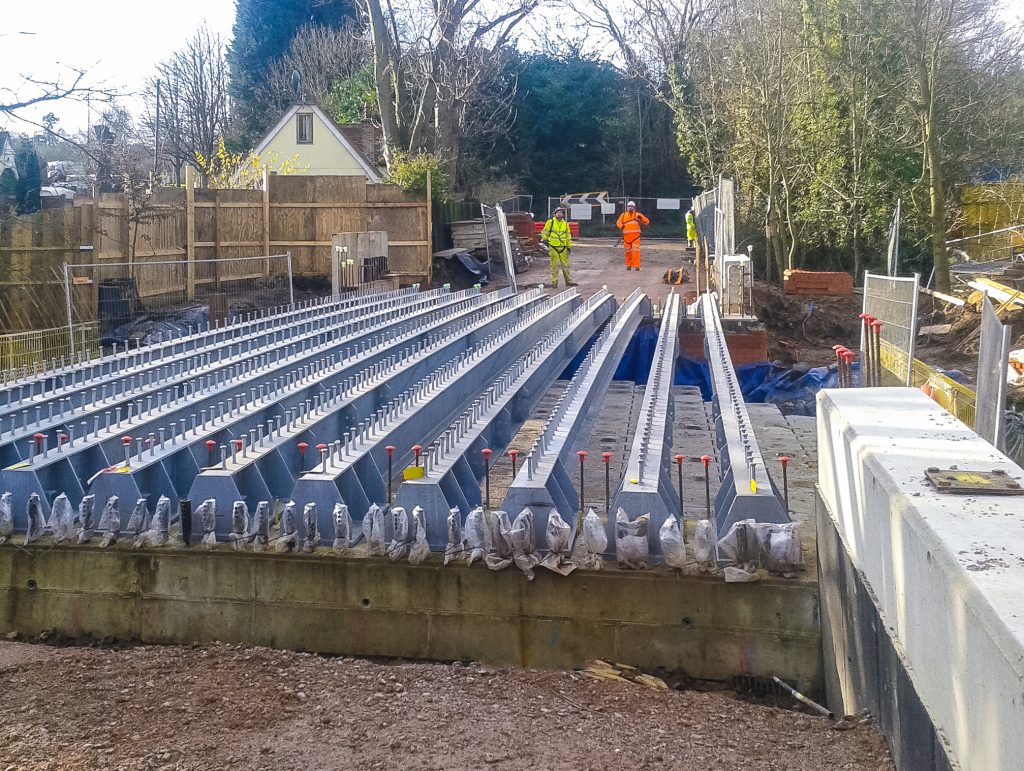The Mersey Gateway Bridge
Title: The Mersey Gateway Bridge
Name of fabricator: Cenpart
Galvanized by: Joseph Ash Walsall
End client: Merseylink
Finish provided: Hot dip galvanizing
Size and amount of steel: 250 tonnes of steel
Project goals
The Mersey Gateway Bridge was built as part of the Mersey Gateway Project.
This was a major civil engineering scheme to build a new six-lane cable-stayed toll bridge, and a 9-kilometre road network connecting the new bridge to the main motorway network in the North West of England.
Merseylink had the responsibility for the design, build, finance, operation and maintenance of the new bridge and associated road infrastructure over a 30-year period.
What happened
Due to the large span of the bridge and its exposed nature, at the design stage there were concerns about the effect of high winds on crossing vehicles, particularly high-sided ones. A wind deflection barrier was therefore designed to withstand a once in 50-year wind event (based on historical data) and protect the crossing vehicles.
Due to local prevailing winds the barrier was designed to be higher on one side (4m) than the other (2.5m), as it would be more susceptible to higher winds from that side.
To form the important wind deflection barriers, Cenpart was commissioned to fabricate the steel support posts and clamping brackets, that carry the C shaped Perspex horizontal members.
Cenpart chose Joseph Ash’s Walsall plant to hot dip galvanize the steel.
Hot dip galvanizing has been used worldwide for well over a century because it provides a long-life, low-maintenance corrosion protection which safeguards steel from atmospheric attack. This is incredibly important in huge scale engineering projects that need to provide safety standards for the public, as well as longevity for the structure being built.
Once fabricated, Joseph Ash Walsall collected the steel from Cenpart’s grit blasters. The posts required gritblasting to SA 2.5 standard as the specification for galvanizing called for a 140 micron nominal thickness coating. This was easily achieved, and Joseph Ash’s quality department recorded average pick up thickness throughout the contract to confirm the specification was met.
The 11000 loose clamping brackets were also spun galvanized by Joseph Ash Telford.
Next pageTitle: Hague Construction Ltd engaged Joseph Ash Galvanizing to galvanize steel beams for an Essex bridge
Name of contractor: Hague Construction Ltd
Galvanized by: Joseph Ash Galvanizing
End client: Essex County Council
Finish provided: Hot dip galvanizing

The project
Hague Construction Ltd is a civil engineering and design and build contractor based in Rochester, Kent, specialising in all aspects of in-situ concrete works, ground works, reinforced concrete structures and the design and build of steel framed commercial buildings.
Some of Hague’s partnership agreements include local authorities across the south east such as Kent County Council, Medway Borough Council, Essex County Council and Surrey County Council.
Many of Hague’s projects include highways structures, and as such they were given the task of reconstructing Lexden Bridge in Spring Lane, Colchester, Essex.
The previous Lexden Bridge crossed the channel of the River Colne and was built as a single span structure in 1904, which could only hold a three-tonne weight limit.
The primary elements of the previous steel bridge superstructure consisted of two lattice girder edge beams, 13.44 metres in length, which spanned longitudinally between mass concrete abutments and with a transverse spanning deck. The deck was constructed of steel transverse members in-filled with mass concrete. The clear span between the face of the abutments was 12.18 metres.
Due to the age and structure of the bridge, Essex County Council commissioned Hague Construction to demolish the bridge and replace it with a new reinforced concrete bridge.
The abutments needed to be supported on CFA piles and the raised height of the new bridge deck would require a change to the vertical alignment of the carriageway.
A temporary footbridge and footpath were also required to maintain pedestrian access across the River Colne and a coffer dam is required to enable the abutments to be constructed.
Joseph Ash Galvanizing were asked to hot dip galvanize the steel components of the bridge and deliver them direct to the site in Colchester. We were pleased to assist Hague Construction in this project.
Next pageArchitect: Marks Barfield Architects
Fabricator: Britland
Galvanized by: Joseph Ash Galvanizing
End client: Kew Gardens
Finish provided: Hot dip galvanizing
Size and amount of steel: 18 metres high and over 200 meters long
Project goals
Kew Gardens wished to provide a treetop walkway structure for visitors to the gardens, so that people could experience the nature and the stunning scenery of the park from amongst the treetops.
What happened
Kew Gardens engaged Marks Barfield Architects to design the new attraction. The architects came up with an amazing design and then sought the help of Britland to manufacture and install the metalwork.
Britland engaged Joseph Ash Galvanizing to treat the steel with a galvanized finish that blends well with the environment and will be maintenance-free for 60 years.
In 2008, Bob Ockendon from Britland commented: “The structure itself is unusual in the fact it is formed from ‘weathering steel’ which is only available in sheet form, which then had to be fabricated to make the various members. It is intended to weather to blend in with the environment, but Joseph Ash Galvanizing treated and coated all the grilles and side panels to protect them while matching the surroundings. We decided to go to Joseph Ash Galvanizing because of the service the company offers and the standard of work they have provided in the past.”
Materials and size
The entire structure is 18 metres high and over 200 meters long. Visitors have to climb 118 steps to reach the top… or take the lift!
Outcome
The Treetop Walkway at Kew Gardens opened on International Biodiversity Day in 2008. With over 300 acres of land at Kew Gardens, beauty is as far as the eye can see. Especially when visitors to the park can walk amongst the treetops of sweet chestnut, lime and oak trees.